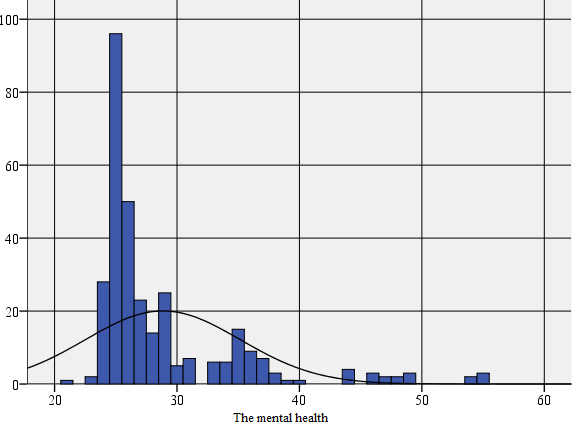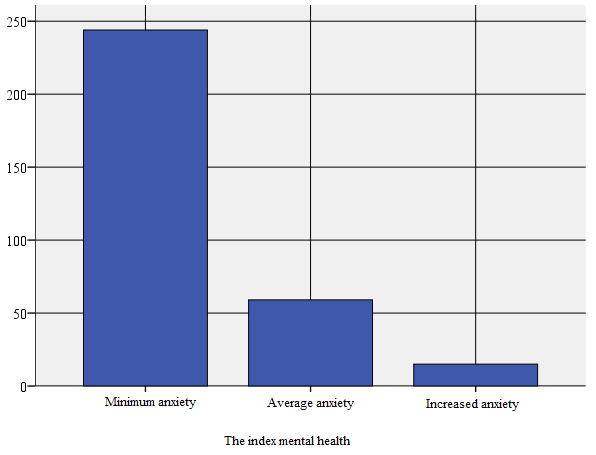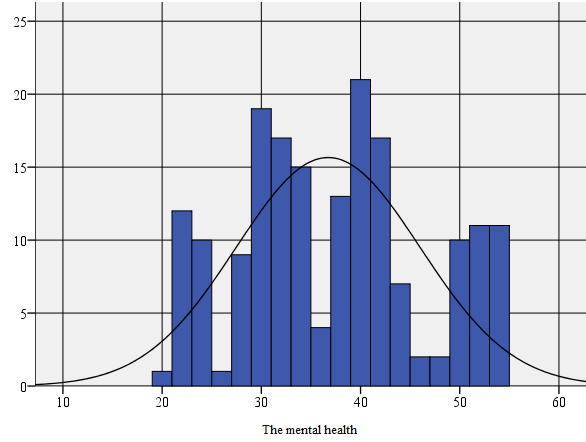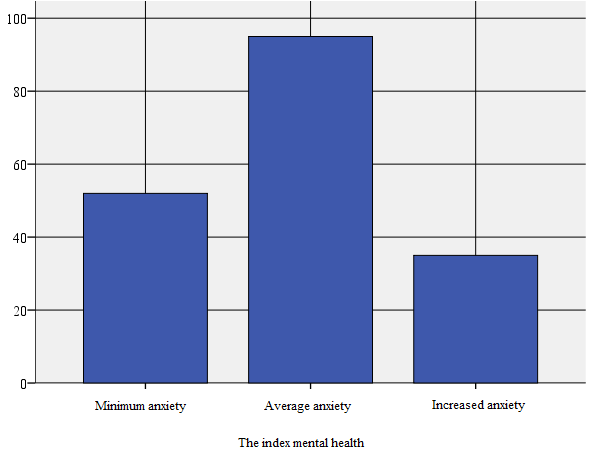Abstract
Traditionally, physical activities exert favourable effects on physical and motor development of the individual. This truth is already well-known, but that idea does not take into account that the individual is a bio-psycho-social complex, and any influence exerted on him causes changes on all of its components. In this context, the present study aims to highlight the correlation between mental health that adults perceive and identify the proportion of practicing leisure sports activities in their free time. We applied a multiple survey, centred on the main component of quality of life, health, and the investigation of the declared / perceived mental health was considered as one of the subcomponents. The questionnaire-based survey focused on psychic sphere included 20 questions. In terms of targeted content and interpretation of data, the level of the anxiety index in adults who practice or not leisure sports activities was emphasised. The collected data were grouped by age, educational level and subjects’ gender. The Results of study leads that practice of physical exercise improved mental health of the individual, especially since the amount of time spent on such activities is higher.
Keywords: Mental healthanxietyleisure sports activities
Introduction
Psychologists describe anxiety as a nonspecific fear, a constant concern without any particular
reason, which can give you sleepless nights, with a persistent impression of threat etc., all symptoms
being present without any basis.
Anxiety overtakes a "normal" limit when the length of disorders exceeds six months, affecting
work and relationships with others and the individual is in the position of not having the opportunity to
control the symptoms that take hold of him. Also, Scott et al. (2007) point out that there is a correlation
between the mental state of individuals and their physical condition, emphasizing that those with anxiety
or depression disorders are more likely to have chronic physical conditions. Fox K.R. (1999) showed that
exercise has a moderate reducing effect on state and trait anxiety and that aerobic and resistance exercise
enhance mood state. The same idea is also revealed in the study conducted by Taylor A.
H. (2000) which demonstrated that physical activity has a low-to-moderate effect in reducing
anxiety.Schmitz et al. (2004) reported that physical activity has been found to improve mental health
conditions, particularly anxiety, depression and general well-being.According to the therapist Sally A.
Connolly, "physical and psychical benefits brought by sport can lead to the improvement of the
symptoms caused by anxiety and depression. Research shows that at least 30 minutes of physical exercise
performed 3-5 days a week could bring significant improvements". Moreover, some studies compare the
benefits of physical activity to those made by drug therapy, demonstrating that the effects of the physical
exercise can persist after a longer period of time (Maroşan, 2012).
Nechita (2013) mention that the practice of sport is the most important section in health
improvement aimed at restoring functions diminished, increasing functional and even take compensatory
mechanisms in case of functional rehabilitation.
Problem Statement
All theabove referencedstudies lead us to believe that, in addition to other more or less specific
and traditional interventions, in these situations of bio-psycho-social imbalance, you can choose to
engage in recreational sports as a primary or complementary mental sphere means of rehabilitation. If
they arecarried out constantly under specialist supervision, they willundoubtedlyhave the effect of
reducing the intensity of symptoms associated with anxiety and, in general, can lead toan improvement
in health.
The Eurobarometer survey conducted in 2013, concerning the countries and the share of
population in terms of practicing sport / leisure sport activities, placesRomaniaon the second-to-last
position in relation to the other European countries(Craciun, 2014).
Research Questions
Our research aims to reveal if there is a link betweenthe poorRomanian citizen participation in
sport/leisureactivitiesandtheir own level of perception of their mental condition.
Purpose of the Study
This study aims to highlight the correlation between mental health perceived by adults and the
importance that they attach to practicing leisure sports activities in their free time.
The research was conducted during October 2012 - March 2013, on a sample of 500 adults, with
ages ranging from 25 to 49 years old.
Research Methods
Within this research, we applied a survey centred on the main component of quality of life -
health, whilst mental health investigation declared / perceived by respondents was considered as a
subcomponent.
The survey contained 20 questions, with interpretation values of the results between 1 and 60
points. The values of the applied survey were:
items, and the results were interpreted as follows: between 20-40 points "lowanxiety"; between 41-49
points "average anxiety"; between 50-60 points "increased anxiety" (Bădeliţă, 2014).
The survey was applied in Brasov on subjects from the targeted group, both at the beginning and
ending oftheir various leisure sports activities and also on subjects interviewed on the streets for all
categories of adults.
The investigation was focused on subjects who stated they practiced leisure activities with a
certain degree of constancy (different sports: cross country running, hiking, jogging, mountain running,
running in parks, sports games, activities in gyms, cycling, swimming, skiing etc.), as well as on subjects
who stated they did not practice sports (interviewed on the street). Subjects participating in mass sports
activities organised by regional / local institutions, sports associations, non-profit organisations etc. have
also been investigated. The survey included closed, open and foreshadowed responses.
The collected data were grouped by age, educational level and gender of the subjects and
subsequently they were statistically and mathematically processed via SPSS.
Findings
The Interpretation of the Collected Data after Applying The Survey Method
Validation of the Survey Focused on Mental Health
This survey achieved an Alpha validity coefficient of 0.703, demonstrating a good level of fidelity
(Table
The State of Mental Health, Depending on Sample, for Adults Practicing / Not Practicing Leisure Sports Activities
Analysing the sample of people who practice leisure sports activities, depending on their mental
health score, it can be noticed that the average value is 28.84. The results deviate from the average, plus or minus, with 6.33 (SPSS 20, 2012).
Modal value is unique and 25. This means that that the most frequent score was 25.
The Kurtosis coefficient is 4.647, which indicates a leptokurtic distribution, with values centred on
the average. The Skewness coefficient (2.142) shows a distribution angled heavily to the left, with more
extreme values to the right.
The minimum score was 21, while the maximum score was 55 (Table

Considering a p-value of less than 0.05, that was obtained after a normal distribution analysis, we
can conclude that thevariable is not normally distributed (Table
People practicing leisure sports activities have in their vast majoritya
show an

The average score in mental health achieved by subjects who
Analysing the score distribution, we can notice these values deviatefrom the average, plus or
minus, with 9.27. The asymmetry coefficient (0.155) shows a left-directed distribution, with more
extreme values to the right. The kurtosis coefficient (Kurtosis=-0.874) indicates a platykurtic distribution,
broader than a normal distribution, with multiple values spread out over a longer interval around the
average (Table

The result of the Kolmogorov–Smirnov test indicates that the variable "state of mental health" in
subjects who do not practice leisure sports activities is not normally distributed (Table
Subjects not practicing leisure sports activities have in their vast majorityan
19.2% show a

The State of Mental Health Depending on The Subjects' Age
The data reveals that most people practicing leisure sports activities (over 75%) have a low anxiety
level (p=0.765) and the difference in perception between age groups is low (Table
For subjects who do not practice leisure sports activities, we notice a higher percentage of mental
health in people aged between 40-44 and 45-49. For the other categories, the percentage of people with
high anxiety is between 20% and 24.1% (Table
The State of Mental Health Depending on The Subjects' Education
The education level of those who practice leisure sports activities is approximately equally
distributed in percentage as per thecriterion of perceiving the minimum level of anxiety (over 70%),
basically with no significant statistical differences for this criterion (p=0.104). However, the lower the
level of education, the more cases of increased anxieties are registered (Table
For the sample of subjects who do not practice sports there is no significant difference either
(p=0.806) regarding mental health index for subjects with different levels of education. However,
compared to the same criterion, there is a trend of perceiving a higher average anxiety in subjects with
higher education who practice this type of activities, where the situation is reversed (the higher the
education level, the lower the level of anxiety) (Table
The State of Mental Health Depending on The Subjects' Gender
Analysing mental health index depending on gender for subjects practicing sports, statistically
there is no significant difference (p=0.380) between men and women. However, a remarkable fact is that
over 74% for both men and women have a low level of anxiety (Table
For the subjects who do not practice sports, gender differences are not significant (p=0.929), but over
50% of respondents perceive their anxiety level to an average level and 18% at a high level (Table
Statistical Relationship between Practicing Leisure Sport Activities and Mental Health
Condition
By applying the t-test for independent samples, it was observed that there are significant
differences between the average scores obtained by subjects practicing leisure sports activities (M=28.84;
Sd=6.331) and not practicing leisure sports activities (M=36.73; Sd=9.274), t (df=279.109) =-10.200;
p=0.001, having equal variances not assumed (F=56.993) (Table
Regardless of age, studies, gender of the investigated subjects, the collected data indicates that the
level of anxiety is lower for those who systematically practice physical exercises and their beneficial
influences are more significant for the age interval of 45-49.
Conclusions
The results obtained allowed us to formulate the following:
The more systematically and continuously physical exercises are done the greater chance to enhance the individual's mental health condition.
Regardless of type of physical activity performed, this research shows it produces beneficial effects on the human mental health.
Higher educated subjects are more affected (positively or negatively) by the experimental factor taken into account, namely, practicing or not practicing leisure sports activities.
Regardless of criteria chosen for subjects, the people who do not practice leisure sports activities have a much higher anxiety level than people whose choice of leisure activities are oriented towards the practice of one, two or more sports.
Acknowledgments
The authors wish to thank Ms Grosz Daniela Nicoleta for translating and copy editing the text.
References
- Bădeliţă, O. (2014). S.T.A.I. forma X1 si S.T.A.I. forma X2 – chestionar de evaluare a anxietatii. Retrived from http://terapiepebune.blogspot.ro/2014/01/stai-forma-x1-si-stai-forma-x2.html
- Crăciun, O. (2014). Eurobarometru: 60% din români nu fac niciodată sport; 6% fac mişcare regulat. Retrived from http://adevarul.ro/news/societate/eurobarometru-60-romani-nu-fac-niciodata-sport-1_533068b40d133766a830b537/index.html
- Fox, K.R. (1999). The influence of physical activity on mental well-being. Public Health Nutrition. 2(3A):411-418.
- Maroşan, I. (2012). Sportul reduce starile de anxietate si depresie. Retrived from http://www.eva.ro/horoscop/astrologie/sportul-reduce-starile-de-anxietate-si-depresie-articol-28608.html
- Nechita, F. (2013). Gimnastica în kinetoterapie. Editura Universității Transilvania Brașov, ISBN 978-606-19-0232-3, 9.
- Taylor, A.H. (2000). Physical Activity, Anxiety, and Stress. In S.J.H. Biddle, K.R Fox, and S.H. Boutcher (editors), Physical Activity and Psychological Well-Being. London, UK: Routledge, 10-45.
- Schmitz, N., Kruse, J. & Kugler, J. (2004). The Association between Physical Exercises and Health -Related Quality of Life in Subjects with Mental Disorders: Results from a Cross-Sectional Survey. Preventive Medicine, vol. 39,1200–1207.
- Scott, K.M., Bruffaerts, R., Tsang, A., Ormel, J., Alonso, J., Angermeyer, M.C., Benjet, C., Bromet, E, de Girolamo, G., de Graaf, R. et al. (2007). Depression-anxiety relationships with chronic physical conditions: results from the World Mental Health Surveys. Journal of Affective Disorders,03(1-3):113-120.
- SPSS 20 (Statistical Package for the Social Sciences). Avaible April 20, 2012 from: http://analize-statistice.eu/.
Copyright information

This work is licensed under a Creative Commons Attribution-NonCommercial-NoDerivatives 4.0 International License.
About this article
Publication Date
25 May 2017
Article Doi
eBook ISBN
978-1-80296-022-8
Publisher
Future Academy
Volume
23
Print ISBN (optional)
-
Edition Number
1st Edition
Pages
1-2032
Subjects
Educational strategies, educational policy, organization of education, management of education, teacher, teacher training
Cite this article as:
Bădicu, G., Grosz, W. R., & Balint, L. (2017). Influences Of Practicing Leisure Sports Activities On Mental Health In Adult Population. In E. Soare, & C. Langa (Eds.), Education Facing Contemporary World Issues, vol 23. European Proceedings of Social and Behavioural Sciences (pp. 1570-1581). Future Academy. https://doi.org/10.15405/epsbs.2017.05.02.193

